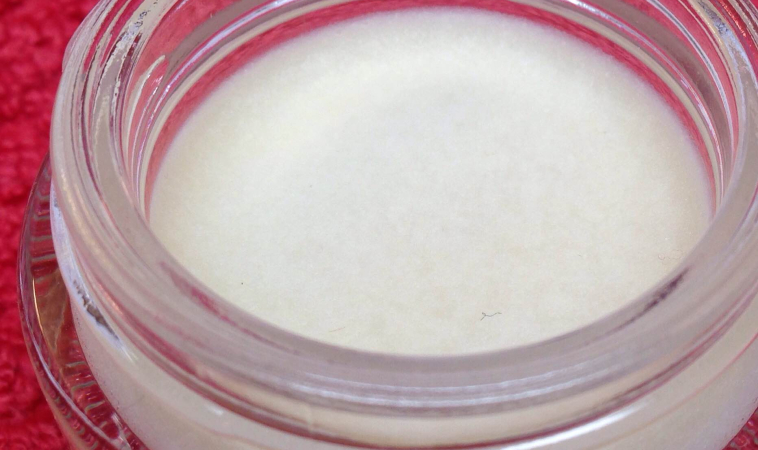Dr. Sarah Cimperman, ND
@drcimperman
During pregnancy, up to ninety percent of women develop stretch marks.1 Many products claim to prevent them but few have been proven effective. The pool of research studies in this area is small, but there is some evidence to support the use of natural remedies. One study found that bitter almond oil prevented the appearance of stretch marks or reduced their severity, while cocoa butter and olive oil did not.1 Another study found that, compared to placebo, a cream containing vitamin E (in the form of alpha tocopherol) was effective at preventing stretch marks during pregnancy.2
This recipe for Baby Bump Balm calls for both almond oil and vitamin E, along with a special ingredient: manuka honey. All honey contains nutrients needed for tissue repair and rejuvenation. Manuka honey, made by bees that gather nectar from manuka trees in Australia and New Zealand, has also been shown to reduce inflammation and stimulate skin cell growth.3 If you don’t have manuka honey, use raw honey from a local beekeeper. Avoid pasteurized honey because heat destroys many of the healing compounds.
The base for this balm is made with a combination of almond oil, which is liquid at room temperature, and shea butter, which is solid at room temperature. The result is a spreadable consistency and a creamy, silky texture. If need be, you can always adjust the consistency by adding more liquid fat (almond oil) to make it softer or more solid fat (shea butter) to make it firmer. If you don’t have shea butter, you can substitute raw cocoa butter. It may not prevent stretch marks, but it’s a natural solid fat and a good carrier for the other ingredients.
I left my Baby Bump Balm unscented but you can add pure organic essential oils if you like. During pregnancy, women can safely use small amounts of certain essential oils topically but they should not be ingested. Studies have shown that lemon essential oil can minimize symptoms of nausea and vomiting,4 which is especially useful during the first trimester when women suffer most from morning sickness. Essential oils of lavender5 and chamomile can promote relaxation, relieve occasional anxiety, and aid sleep. Other essential oils—including peppermint, sage, and oregano—may trigger uterine contractions and should be avoided during pregnancy.
Ideally, use this balm on moist skin after a shower or bath. Scoop some out, rub it between your hands until it melts, then apply it your belly, breasts, hips, and thighs. It’s free of additives, so it takes some time to be fully absorbed. I like to apply it before bed and allow it to soak in overnight. This balm may be designed to prevent stretch marks, but it’s a great moisturizer for the whole body. I also use it on my face, hair, and any areas of dry skin like hands, elbows, and feet.
This recipe makes about two cups of balm. Because the unsaturated fatty acids in almond oil will oxidize at room temperature, I portion some of the balm into a small glass jar for daily use (enough to last about a week) and the rest into a large glass jar that I store in the fridge.
Ingredients:
- 1 cup organic bitter almond oil with vitamin E
- 1 cup organic raw shea butter
- 1 teaspoon manuka honey
- 10 drops pure organic essential oil (optional)
Materials:
- Glass measuring cup for liquids (2-cup or 4-cup)
- Medium saucepan
- Spoon for stirring
- Glass jars with airtight lids
Directions:
- Use hot, soapy water to wash the jars and lids. Set them aside on a clean surface to dry completely.
- Fill a sauce pan (large enough to accommodate the measuring cup) with two inches of water. Warm it over very low heat. Note that too much heat will destroy some of the beneficial compounds.
- Add the almond oil to the measuring cup. Add chunks of shea butter until the level rises to 2 cups.
- Place the measuring cup in the warm water. Be careful not to splash any water inside the cup. Stir the mixture occasionally and leave it in place just long enough for the solid fat to become liquid.
- Remove the measuring cup and place it on a heat-proof surface. Allow the mixture to cool for five minutes.
- Stir in the honey until it is fully dissolved. If you are using essential oils, stir them in as well. Immediately pour the mixture into glass containers and allow them to cool to room temperature. Meanwhile, label the lids with the contents and date.
- Once the balm has cooled completely, cover the jars tightly and transfer them to the fridge overnight. Once set, the balm will turn from clear to opaque.
- Store enough balm for daily use at room temperature and any excess in the fridge. To refill a small container, bring the large container to room temperature and place it in a pan of water over very low heat just until the balm liquefies. Stir it thoroughly before filling the small container. Cool both jars to room temperature and cover tightly before transferring them to the fridge. Once the balm has set, bring the small container back to room temperature for daily use.
Note: To adjust the consistency, liquefy the balm as directed above and stir in more liquid fat (for a softer balm) or solid fat (for a firmer one). Cool it to room temperature and allow the balm to set again in the fridge overnight.
 Sarah Cimperman, ND is the author of the new book, The Prediabetes Detox: A Whole-Body Program to Balance Your Blood Sugar, Increase Energy, and Reduce Sugar Cravings. She graduated from NCNM in 2002 and has a private practice in New York City. Her expertise has been featured on Fox News and Huffington Post and in Natural Health magazine, Whole Living magazine, and the Well Being Journal, among other publications. Dr. Cimperman also writes two blogs, A Different Kind Of Doctor and The Naturopathic Gourmet.
Sarah Cimperman, ND is the author of the new book, The Prediabetes Detox: A Whole-Body Program to Balance Your Blood Sugar, Increase Energy, and Reduce Sugar Cravings. She graduated from NCNM in 2002 and has a private practice in New York City. Her expertise has been featured on Fox News and Huffington Post and in Natural Health magazine, Whole Living magazine, and the Well Being Journal, among other publications. Dr. Cimperman also writes two blogs, A Different Kind Of Doctor and The Naturopathic Gourmet.
References:
1 Korgavkar K and Wang F. Stretch marks during pregnancy: a review of topical prevention. British Journal of Dermatology. 2015;172(3):606-15. http://www.ncbi.nlm.nih.gov/pubmed/25255817
2 Mallol J, Belda MA, Costa D, Noval A, and Sola M. Prophylaxis of Striae gravidarum with a topical formulation. A double blind trial. International Journal of Cosmetic Science. 1991;13(1):51-7. http://www.ncbi.nlm.nih.gov/pubmed/19291041
3 Eteraf-Oskouei T and Najafi M. Traditional and Modern Uses of Natural Honey in Human Diseases: A Review. Iranian Journal of Basic Medical Sciences. 2013;16(6):731–742. http://www.ncbi.nlm.nih.gov/pmc/articles/PMC3758027/
4 Yavari Kia P, Safajou F, Shahnazi M, and Nazemiyeh H. The effect of lemon inhalation aromatherapy on nausea and vomiting of pregnancy: a double-blinded, randomized, controlled clinical trial. Iranian Red Crescent Medical Journal. 2014;16(3):e14360. http://www.ncbi.nlm.nih.gov/pubmed/24829772
5 Toshiko Igarashi. Physical and Psychologic Effects of Aromatherapy Inhalation on Pregnant Women: A Randomized Controlled Trial. Journal of Alternative and Complementary Medicine. 2013;19(10):805–810. http://www.ncbi.nlm.nih.gov/pmc/articles/PMC3804257/
















